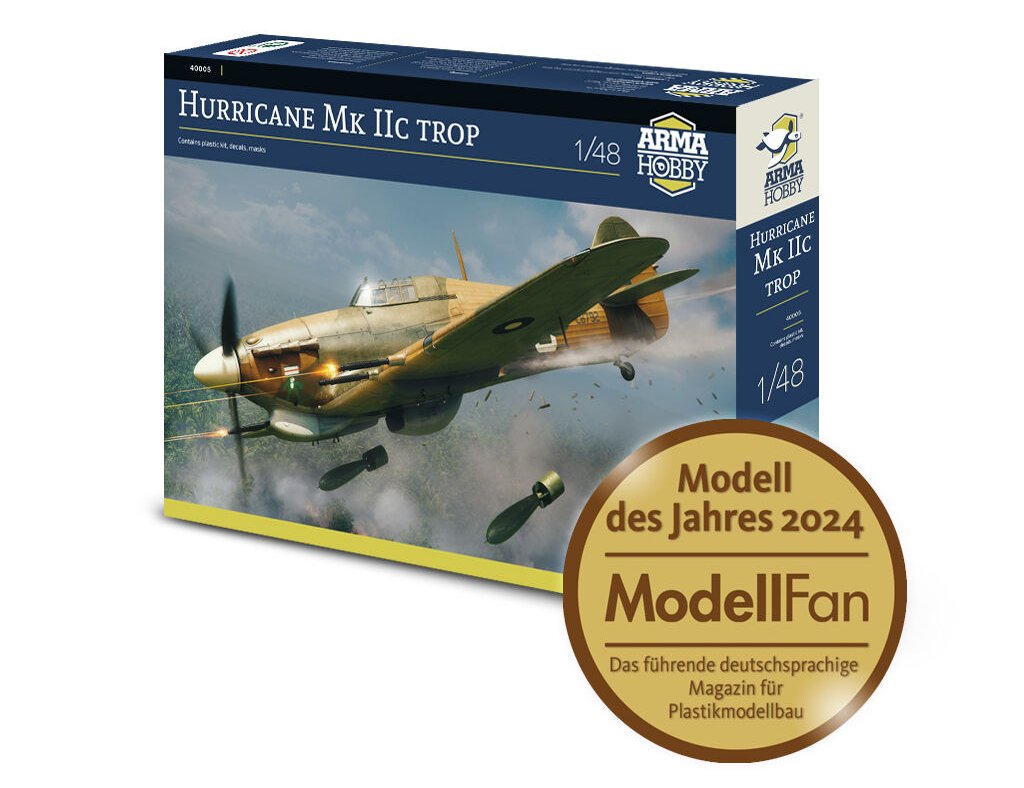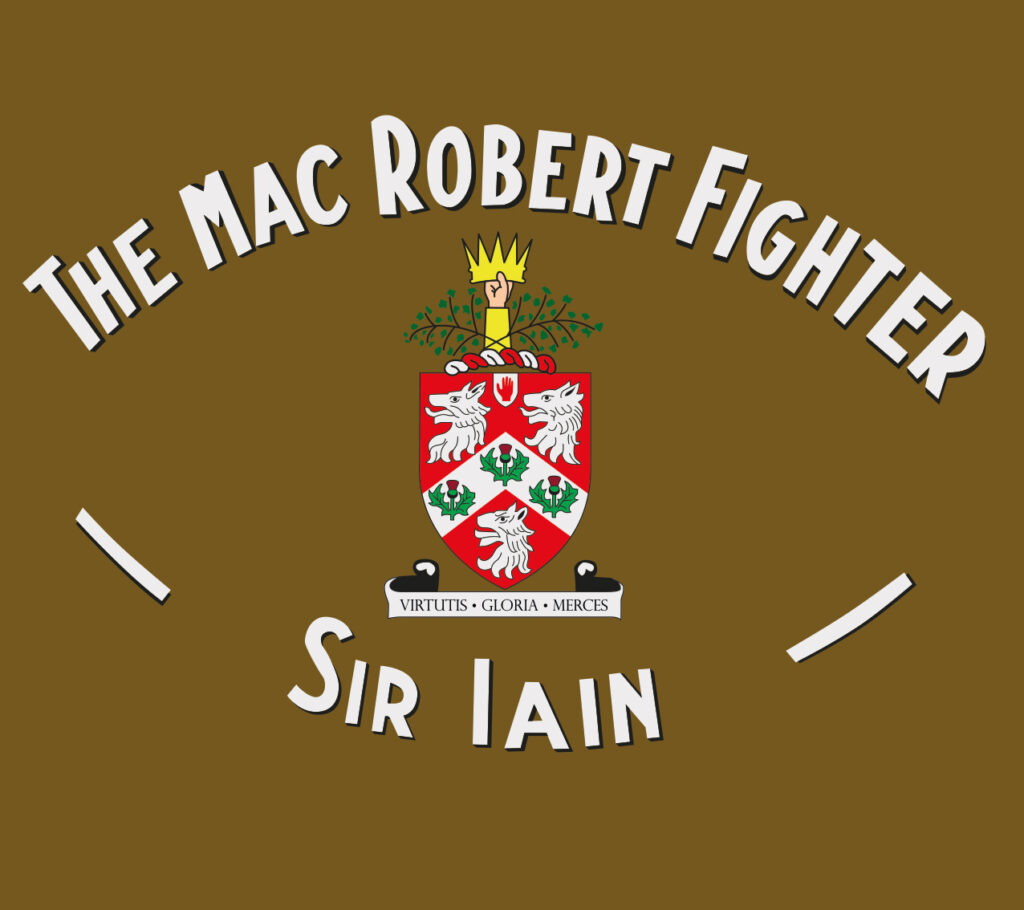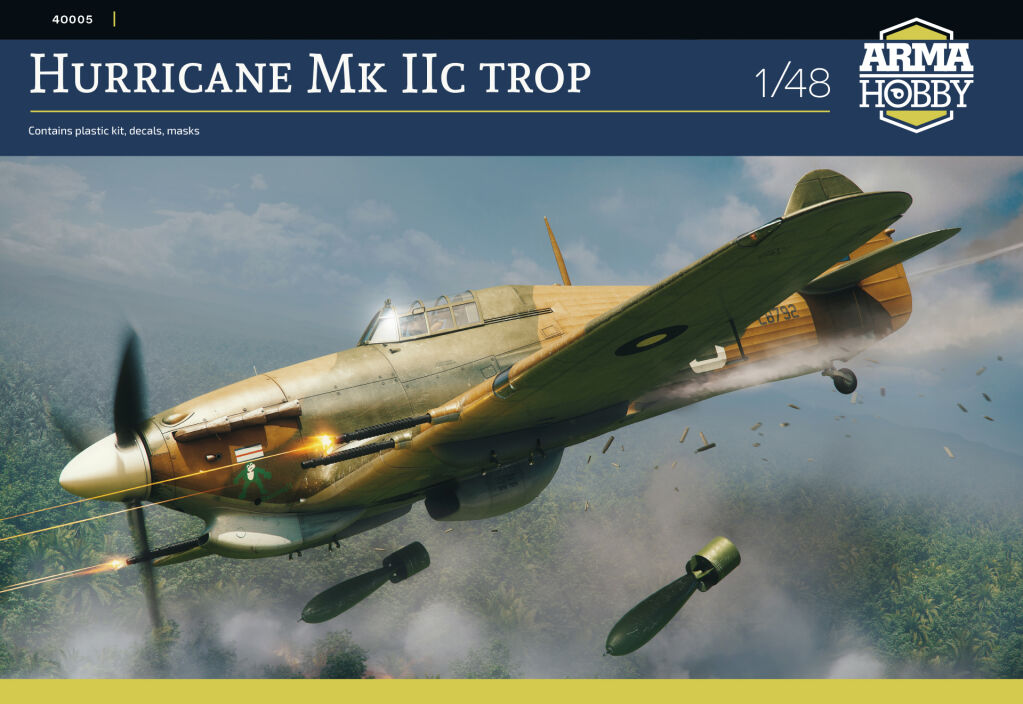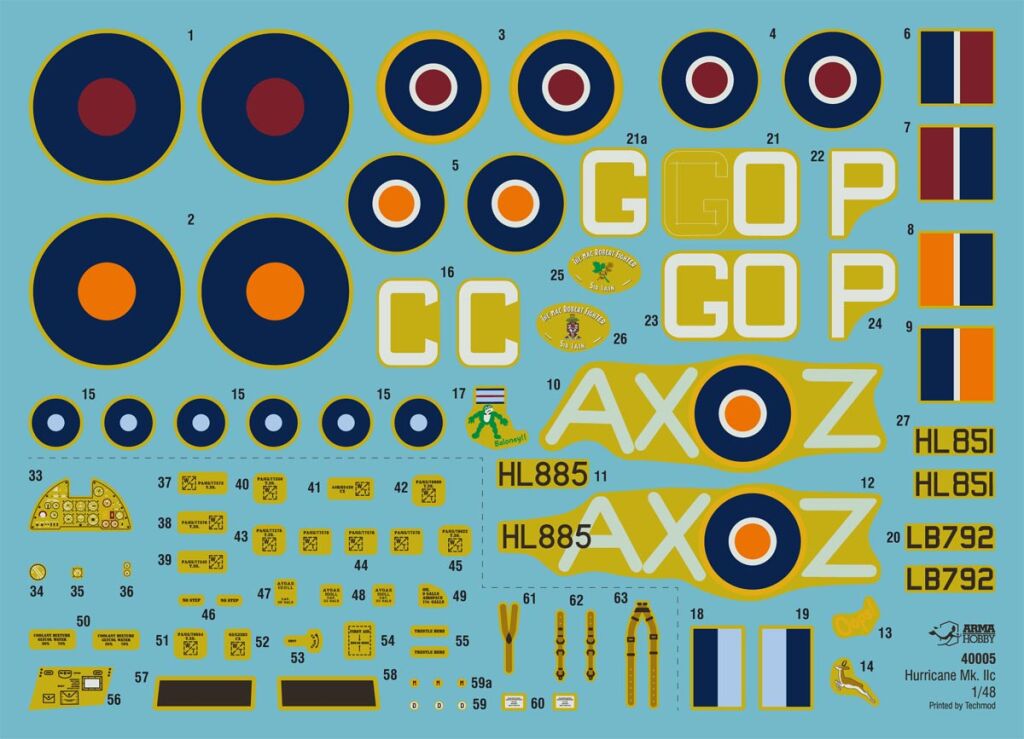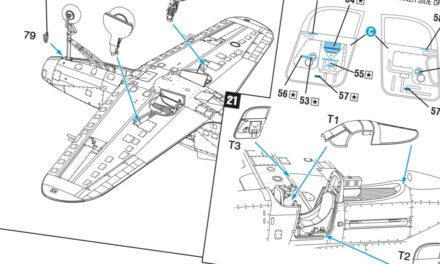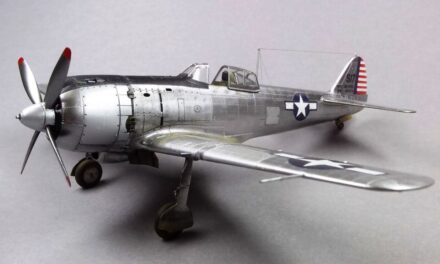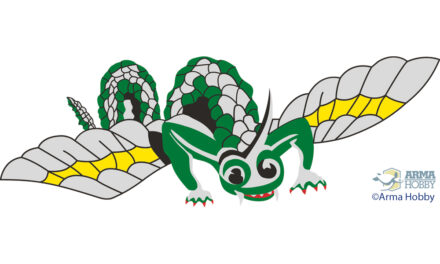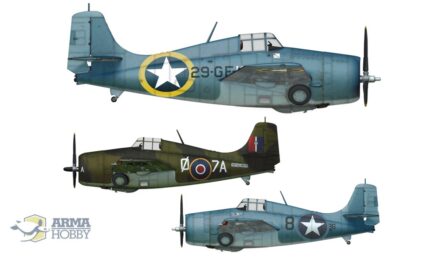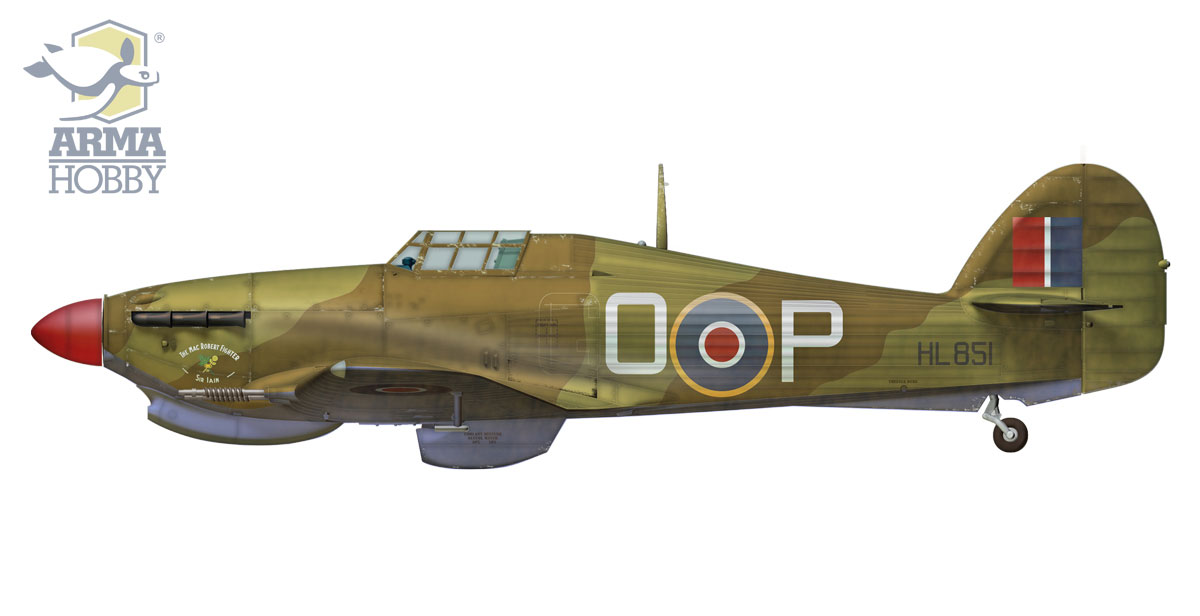
‘It is with a mother’s pride that I enclose a cheque for £25,000, and with it goes my sympathy to those mothers who have also lost their sons, and gratitude to all other mothers whose sons so gallantly carry on the fight.’[1]
With just a single flourish of her wrist, Lady Rachel Workman MacRobert proved how the pen can indeed be mightier than the sword. Reeling from having lost all three of her sons to air crashes and operations in just three years, she channelled her grief into purchasing a Short Stirling bomber for the Royal Air Force during the Second World War. Shortly afterwards, she gifted a further £20,000 to buy a flight of four Hawker Hurricanes, three of which bore the names of her dead sons: ‘Sir Alasdair’, ‘Sir Roderic’, and ‘Sir Iain’. Thus, the most powerful force on the planet – a mother’s love – had been weaponised into warbirds, ready to carry on the fight in place of her fallen boys.
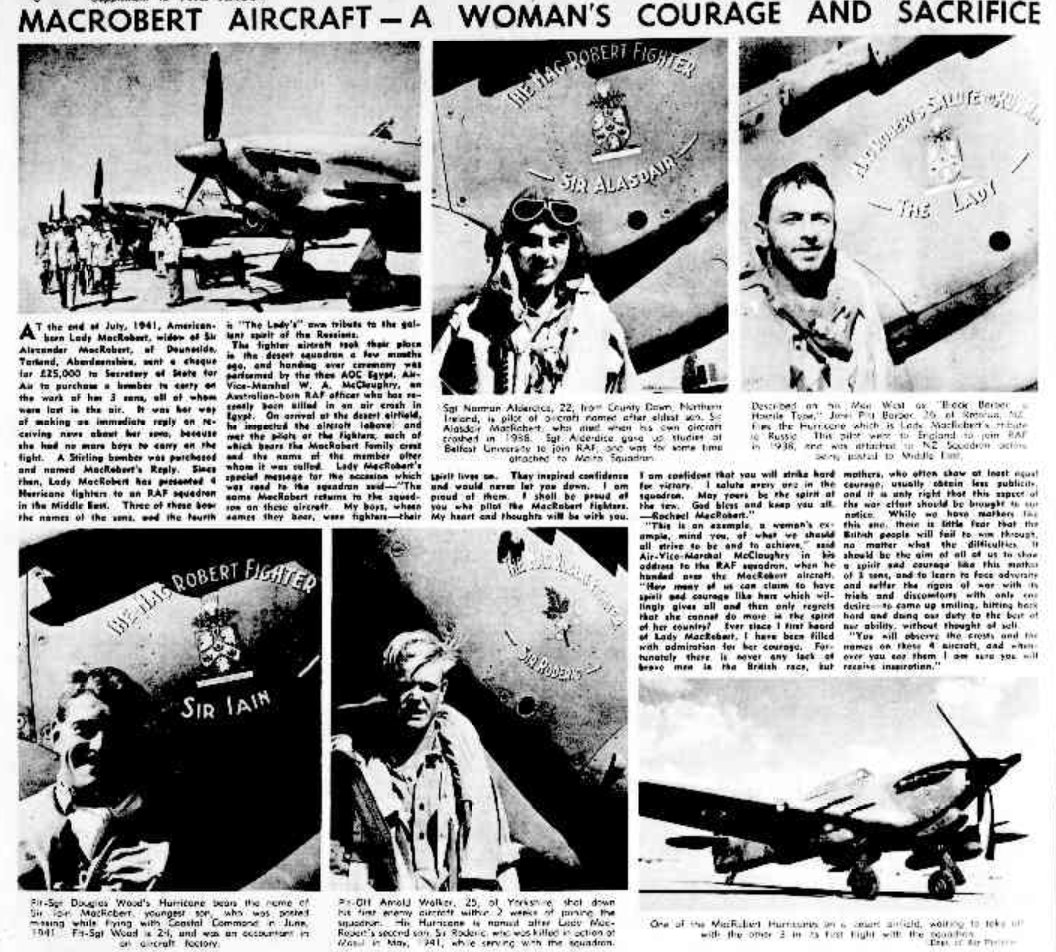
Article from the Australian newspaper “The Argus”, 16 January 1943 r.
One of the ‘MacRobert Fighters’, Hawker Hurricane Mk.IIc Trop HL851 (better known as “The MacRobert Fighter-Sir Iain”) is faithfully depicted by Arma Hobby in one of the decal options for their award-winning 1/48 scale kit.
The story of a mother and three sons
When constructing model aircraft kits, the experience can be even further enriched by knowing about the incredible human story attached to it. Sir Iain was named in memory of Lady MacRobert’s youngest son, Pilot Officer Sir Iain Workman MacRobert, who flew RAF Air-Sea Rescue missions over the North Sea with Coastal Command.[2] After Iain’s Bristol Blenheim failed to return on 30 June 1941, she knew she had nothing left to lose and everything to give. If her gifts could help boost the chances of an Allied victory and spare other mothers the soul-wrenching pain she had gone through herself, she would consider them to be worth every single penny.
In 1938, the eldest son and second Baronet, Sir Alasdair Workman MacRobert, had been killed aged 26 in a civil flying accident at Luton aerodrome, just two days after returning from India in his private aircraft[3]. That same year, Sir Roderic Alan Workman MacRobert – the middle brother – joined the RAF as a reservist, before later being posted to the Middle East as a Hurricane pilot during the Second World War. Amid the Battle of Habbaniya in the spring of 1941, the 25-year-old Flight Lieutenant had been tasked with attacking Mosul airfield, an ex-RAF base which had been stealthily taken over by Heinkel He 111s and Messerschmitt Bf 110 Zerstörer (‘Destroyers’) of the German Luftwaffe[4]. During this daring low-level attack on 22 May, Roderic had succeeded in destroying one aircraft at Mosul and was last spotted diving among the dispersed aircraft; his body was recovered and later buried in the British cemetery at Mosul.[5]
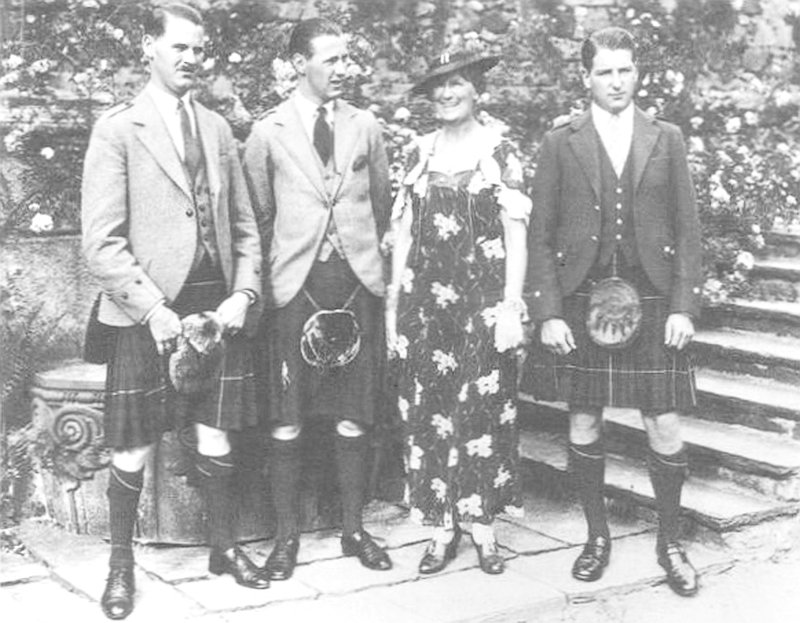
Lady Mac Robert with her three sons: Alasdair, Roderick and Iain. Photo: Findagrave.com
Now, the only brother whose veins still pulsed with fiery MacRobert blood was Iain. Assigned the perilous yet imperative task of locating downed RAF airmen in the choppy North Sea, the 24-year-old set out from RAF Thornaby in North Yorkshire on 30 June 1941 to find an Allied aircrew that were reported as desperately clinging onto their dinghy.[6] Tragically, the rescuer could not be rescued: roughly a month after his brother Roderic had been killed, Iain went missing on the rescue sortie, his body never to be found. Lady MacRobert’s chest ached in anguish at losing her third and final son, although she admitted that ‘I can only hope that my youngest son may yet return.’[7] As a passionate feminist, she lamented the British frontline ban on female fighter pilots: ‘I cannot go and be a pilot myself,’ she expressed regretfully. ‘Had I been a man I, too, would have flown on such service.’[8]
Stirling Bomber…
Having graduated with an honours degree in Chemistry and Geology from the University of Edinburgh – and being one of the first three women to be appointed Fellows of the Geological Society of London – Lady MacRobert possessed a sharp intellect and an indomitable will.[9] She once remarked that ‘we are never finished. The MacRoberts always fight on.’[10] Thus, after Iain went missing, Lady MacRobert felt compelled to do battle through the most effective means available to her: opening a chequebook. Her first gift of £25,000 to the British Air Ministry was subsequently earmarked to buy one Short Stirling, a four-engined heavy bomber. She requested that it would bear the name ‘MacRobert’s Reply’, as ‘it is my wish to make a mother’s immediate reply in the way that I know would also be my boys’ reply – attacking, striking sharply, straight to the mark.’[11]
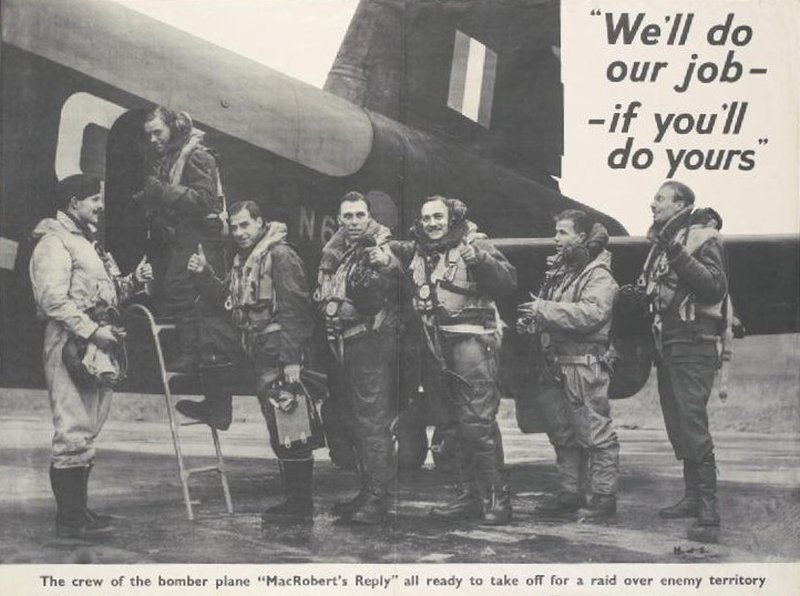
Short Stirling ‘MacRobert’s Reply’ and its crew. Photo: Imperial War Museum/Public Domain via Wikimedia Commons
She spoke of her belief that her boys ‘would be glad that their mother replied for them and helped to strike a blow at the enemy’[12] and that ‘nothing will be worthwhile if this vile enemy is not beaten. Although they killed one of the sons in Iraq, I want them to know they cannot kill the fighting spirit exemplified by the MacRobert brothers.’[13] In a letter to Sir Archibald Sinclair, the Secretary of State for Air, she suggested that the bomber may ‘carry the MacRobert crest – two fronds of bracken, with hands grasping an Eastern Crown, or simply our badge – a frond of bracken and an Indian rose crossed. Let it be used where it is most needed. May good fortune go with those who fly it.’[14] The family crest that was suggested bore the Latin motto of the MacRobert clan: Virtutis gloria merces (‘Glory is the Reward of Valour’).[15]
The crest and the badge of MacRoberts as painted on the ‘Sir Iain’ fighter
Sinclair willingly acquiesced, with the MacRobert’s Reply Stirling venturing into action with RAF Bomber Command’s 15 Squadron during late September 1941. The aircraft flew twelve operational sorties and bombed German towns and cities such as Nuremberg, Hamburg, Bremen, Wilhelmshaven, Cologne, and Munster. One of its most famous sorties was the RAF daylight attack of 18 December 1941 against the German battleships Gneisenau and Scharnhorst at the French harbour of Brest. Accompanied by four-engined Handley Page Halifax bombers and twin-engined Avro Manchester bombers, MacRobert’s Reply flew among the Stirlings that had led the way.[16] Unfortunately, the original aircraft was written off in an air crash during February 1942; its successor, Stirling W7531, was then brought down three months later.[17] Yet, this did not deter 15 Sqn from always counting a MacRobert’s Reply among its ranks – even until the Squadron’s eventual disbandment in 2017.[18]
A few months after she pledged the money for the Stirling bomber, Lady MacRobert bestowed the Air Ministry with another £20,000 in order to purchase four Hurricanes for the RAF’s Fighter Command. Her mind had been captivated by the possibility of directly carrying on Roderic’s work in the Middle East by driving the Germans out of Iraq, thus easing pressure on the Soviet Union in the Caucasus. Wishing to honour the family’s links to India – and to also show Allied solidarity with the Soviets – she noted that, ‘as our family has long been associated with India, it is right that the name should be on the front nearest to India, where our R.A.F. would be helping Russia. I feel that my son, Sir Roderic, when he fell attacking the German planes at Mosul, did something to upset their plans at the time.’[19]
…and four Hurricanes
Consequently, the four Mk IIc Hurricanes – the ‘MacRobert Fighters’ of Sir Alasdair (HL844), Sir Roderic (HL735) and Sir Iain (HL851), along with ‘MacRobert’s Salute To Russia – The Lady’ – entered RAF service in September 1942. They were to be assigned to 94 Squadron based at El Gamil airfield in Egypt, the same Hurricane squadron that Roderic had flown with. Its commander was Squadron Leader Donald Scott, a 23-year-old Battle of Britain veteran who had won the Distinguished Flying Cross (DFC) and had six confirmed aerial kills to his name.[20] Now in the thick of the Western Desert campaign, the Squadron had deployed the first RAF night-fighter unit in the Middle East and claimed to have shot down seven Junkers Ju 88 bombers around the Suez Canal between September and October 1941.[21] It was announced that the groundcrews who had been in action at the same time as Sir Roderic would be on hand to service the Hurricanes.[22]
On 19 September 1942, the four Hurricanes were delivered to Port Said in northeastern Egypt and then formally received in a handing-over ceremony conducted by the Air Officer Commanding in Egypt, Air Vice-Marshal Wilfred Ashton McClaughry. During the ceremony, he gratefully shook the hands of the four young Hurricane pilots destined to fly the MacRobert Fighters. Sir Alasdair was to be flown by the 22-year-old Flight Sergeant Norman Alderdice, a native of County Down, Northern Ireland who had previously served in Malta.[23] Next, Sir Roderic would be piloted by the 25-year-old Pilot Officer Arnold ‘Blondie’ Walker of Yorkshire; he had already been credited with his first aerial victory within only two weeks of joining 94 Squadron.[24] Salute To Russia – The Lady, meanwhile, would come under the command of 26-year-old New Zealander John Pitt Barber, who was described on his ‘Mae West’ life preserver as ‘Black Barber, a Hostile Type’![25]
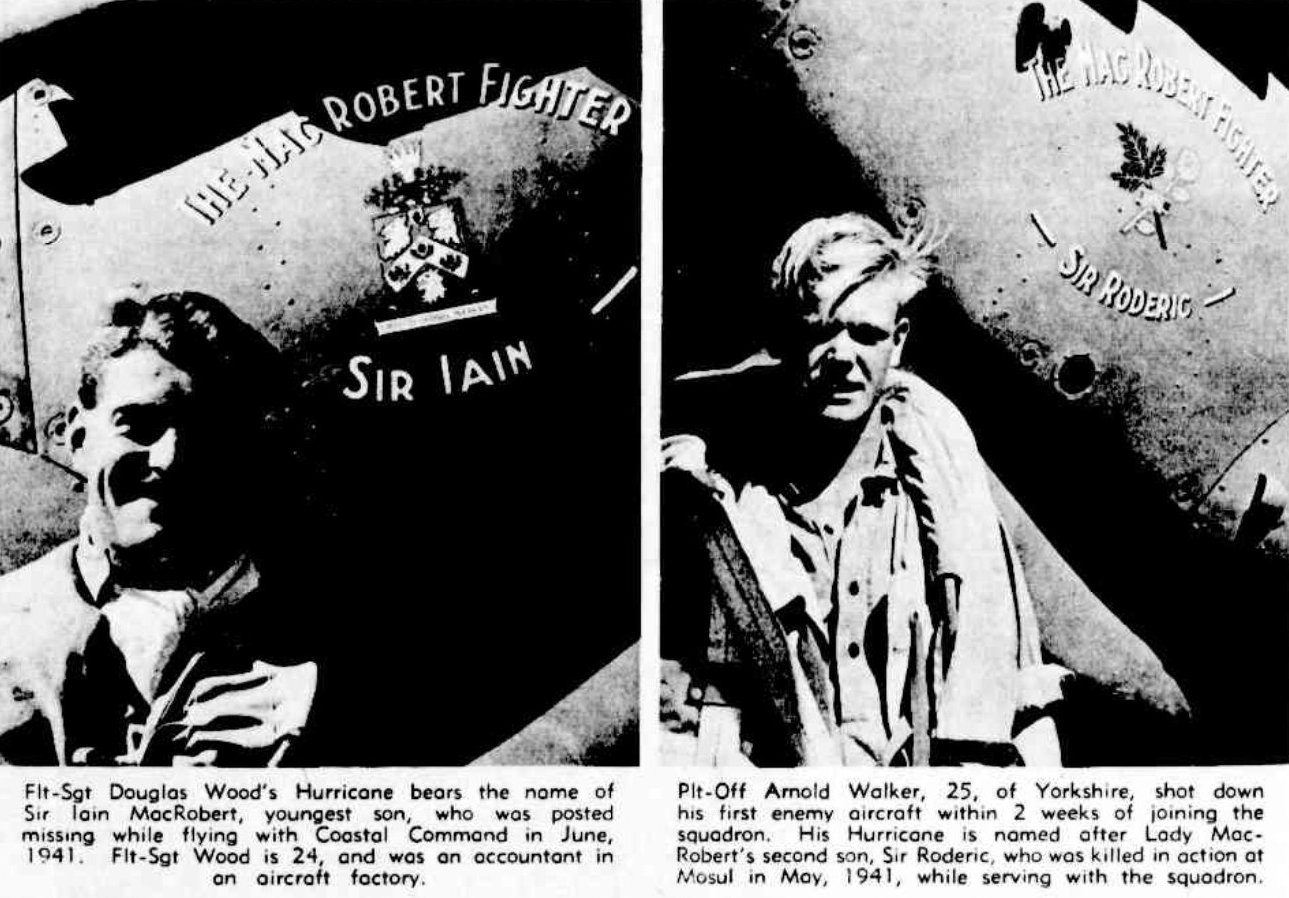
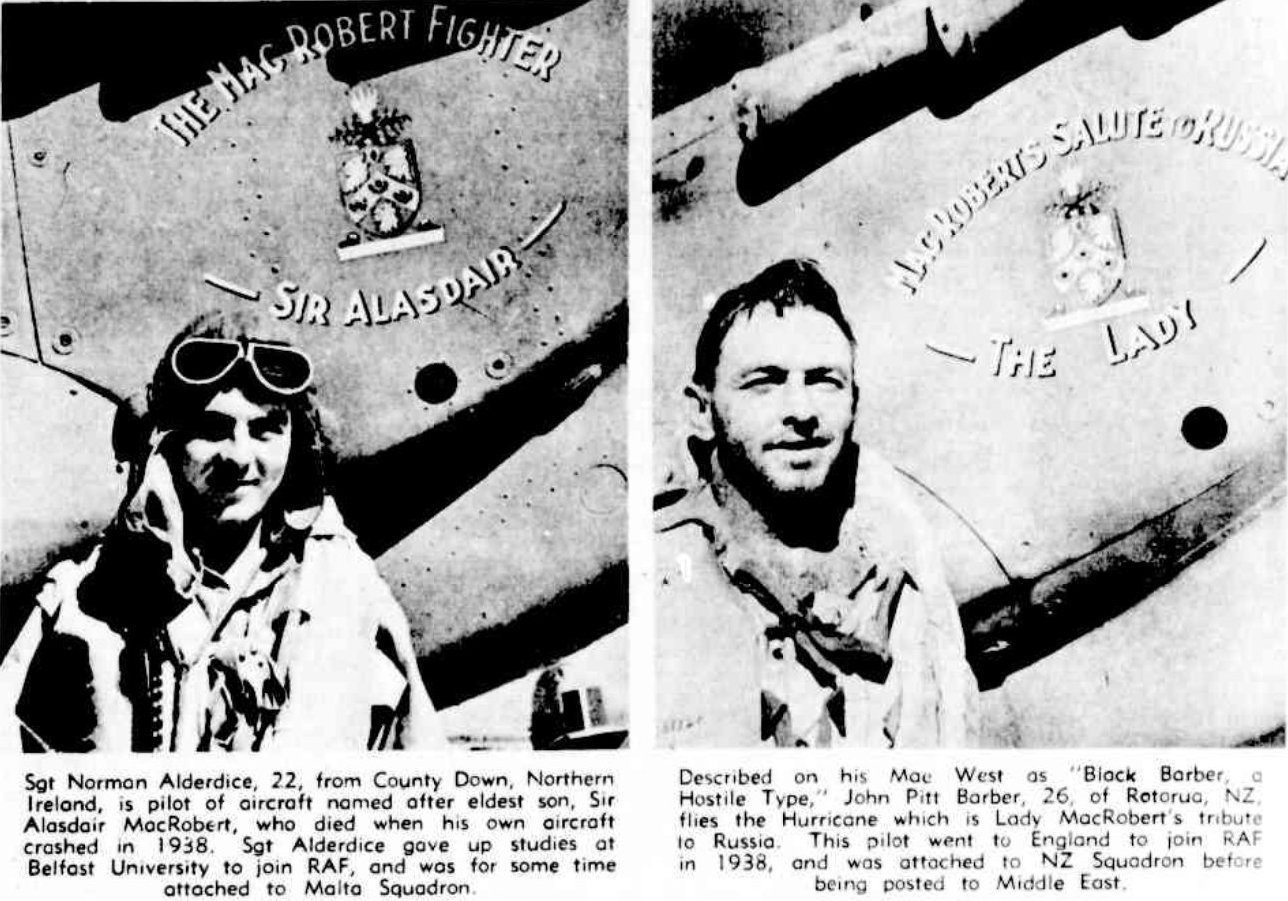
The pilot allocated to Sir Iain was Flight Sergeant Douglas Wood, a 24-year-old who had initially been an accountant with an aircraft factory before his flying career.[26] Sir Iain and Sir Roderic’s serial numbers occasionally get swapped around in the historical literature, but the original Pathé news coverage of the handing-over ceremony shows that Sir Roderic (HL735) was second in line after ‘Salute To Russia – The Lady’.[27] The third aircraft along (HL851) appears to say ‘Sir Iain’ on the nose, and is located behind the clearly visible fourth aircraft in line, Sir Alasdair.[28] This is further corroborated by extended Associated Press (AP) coverage of the ceremony, which provides supplementary angles of the aircraft.[29]
Another source which supports this is an Imperial War Museum photograph of Sir Iain, Sir Roderic and Sir Alasdair mid-flight, in which the writing on the nose of HL851 appears too short to read as ‘Sir Roderic’ or ‘Sir Alasdair’ at the bottom, or ‘MacRobert’s Salute to Russia’ at the top.[30]
Finally, a photograph owned by the Australian War Memorial displays Flight Sergeant Wood shaking hands with Air Vice-Marshal McClaughry next to his Hurricane, which clearly states ‘Sir Iain’ and appears to be the third fighter along in the line of inspection during the ceremony.[31]
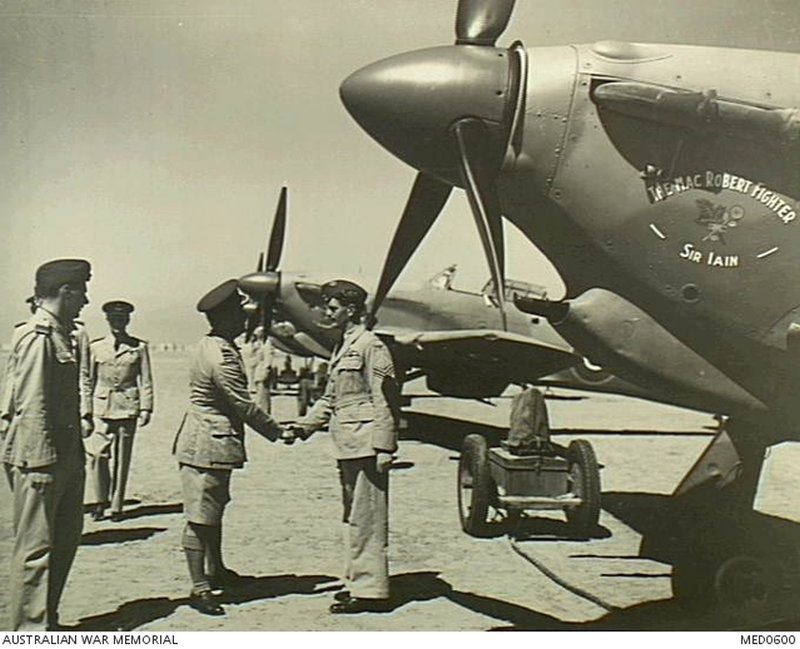
Before the men could mount their new steeds, however, Air Vice-Marshal McClaughry had a message for them that had been written by Lady MacRobert herself:
“The name MacRobert returns to the squadron on these aircraft. My boys, whose names they bear, were fighters. Their spirit lives on. They inspire confidence and would never let you down. I am proud of them. I shall be proud of you who pilot the MacRobert Fighters. My heart and thoughts will be with you. I am confident you will strike hard for victory. I salute everyone in the squadron. May yours be the spirit of the few.[32] God bless and keep you all” – Rachel MacRobert.[33]
McClaughry commented that ‘while we have mothers like this one, there is little fear that the British people will fail to win through, no matter what the difficulties. This is an example, a woman’s example, of what we should all strive to be and to achieve.’ He then indicated the four Hurricanes, adding that ‘you will observe the crests and the names of these four aircraft and, whenever you see them, I am sure you will receive special inspiration from the circumstances in which the squadron acquired them.’[34]
How were the ‘MacRobert Fighters’ painted?
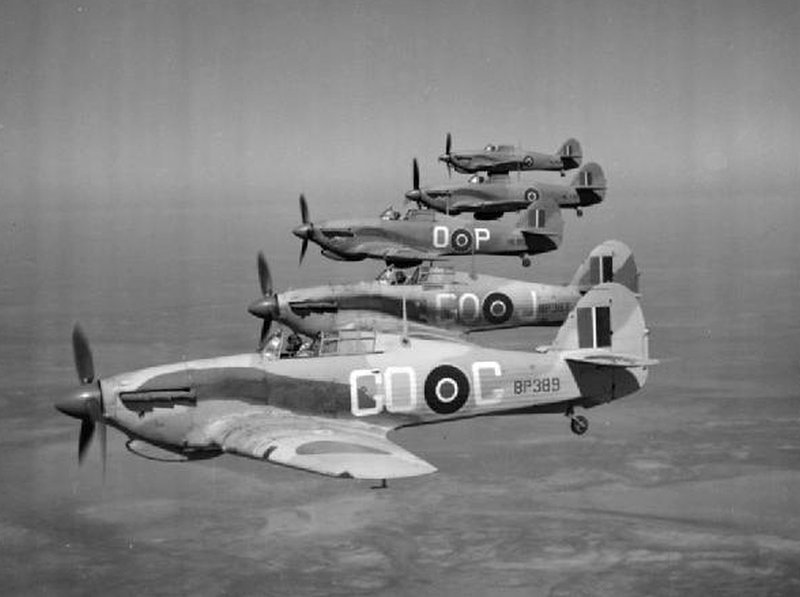
Photo: Imperial War Museum/Public Domain via Wikimedia Commons. See the photo in high resolution on the IWM website
The reason that Arma Hobby’s model of Sir Iain can be customised with one of three squadron code decal options is because there is a famous picture of the aircraft flying that shows only part of its squadron code letters ‘GO-P’ applied on the fuselage.[35] As such, it is possible for the modeller to choose whether to leave HL851 without squadron codes as first delivered, partly apply them, or have all codes adhered.[36]
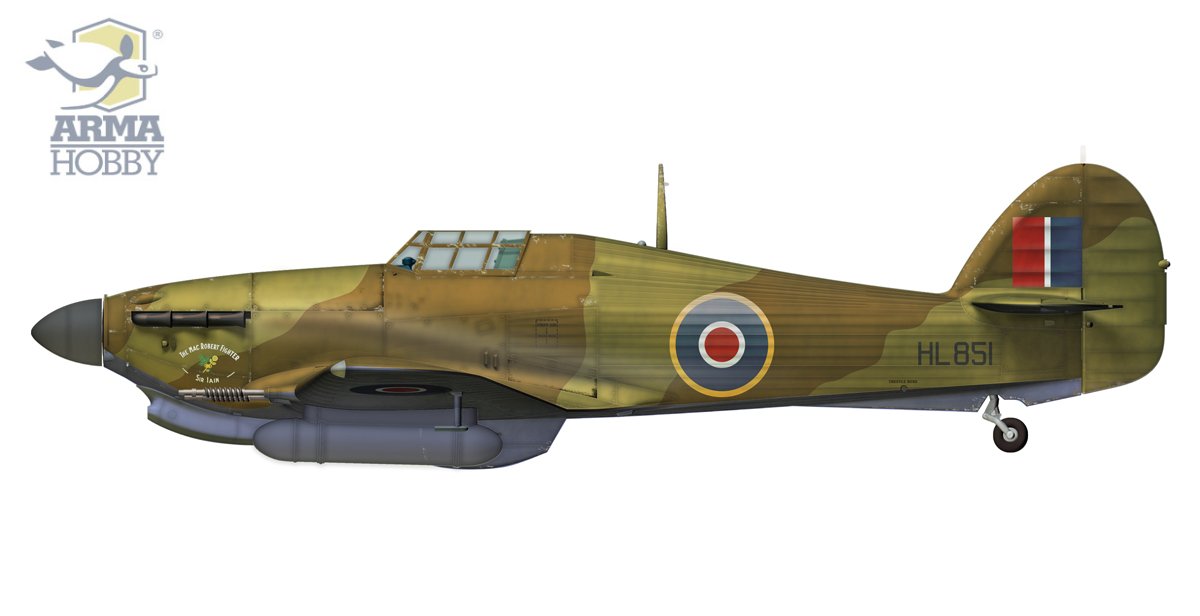
I. Initial variant. No squadron markings and factory black spinner. Auxilliary fuel tanks under the wings

II. Transitional variant. Mediterranean Theatre of Operations regulation red spinner and unfinished squadron code markings. Auxilliary tanks removed. Tank attachement areas remain unpainted in Azure Blue (probably Sky or Medium Sea Grey).
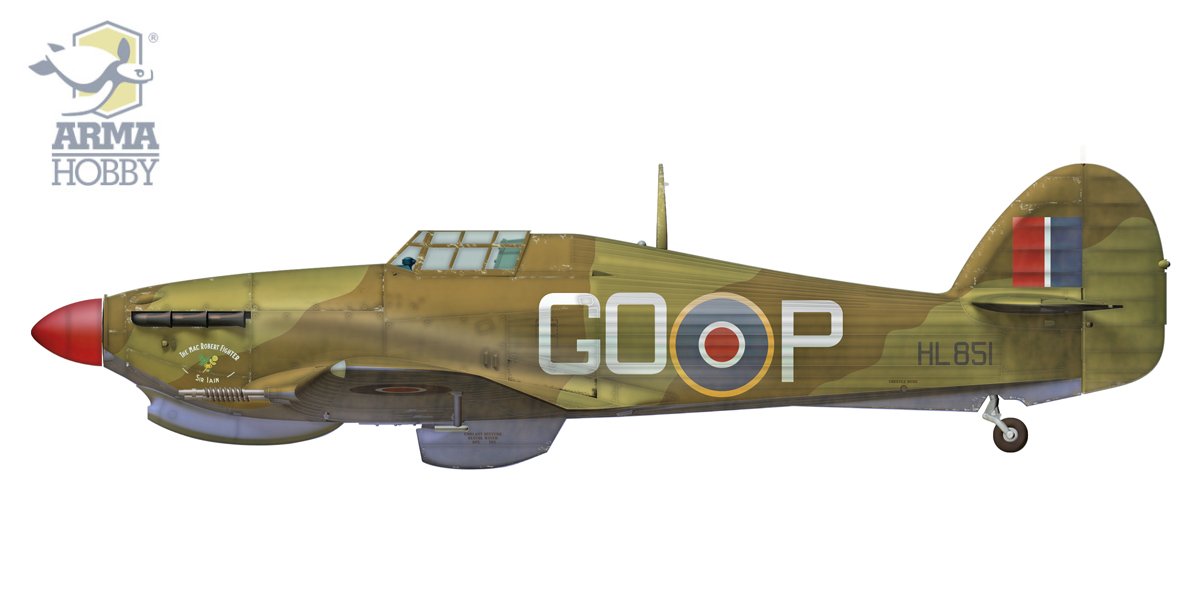
III. Final variant – full squadron code markings
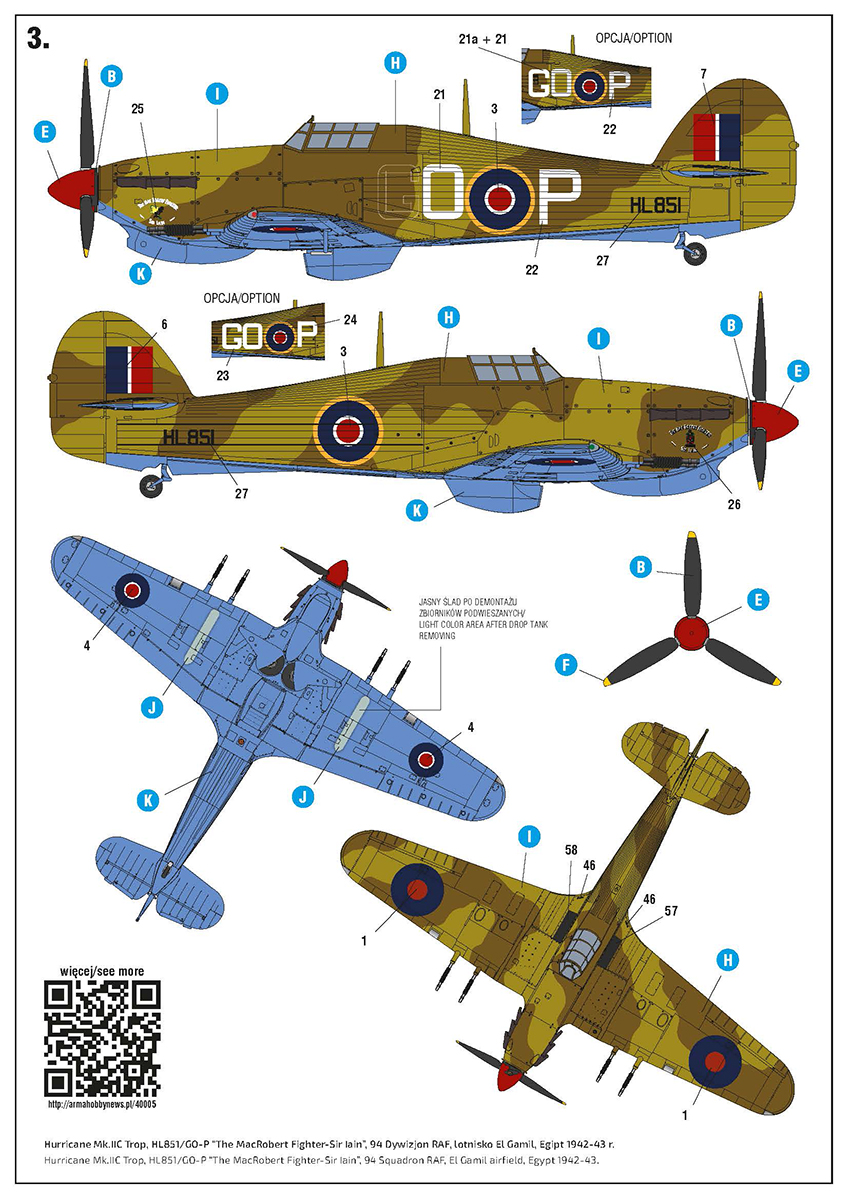
Daubed in full desert livery, Sir Iain is painted in Dark Earth and Middle Stone camouflage, with its undercarriage and wings saturated in Azure Blue to blend in against the North African skies.[37] Light patches, probably Sky or Medium Sea Grey, were left under the removed fuel tanks attachement areas.
- Photo of Hurricane ‘Sir Alasdair’ with auxilliary tanks and black spinner on the IWM website
- Photo of two ‘MacRobert’ Hurricanes with patches of different colour under auxilliary tanks attachement areas on the IWM website
Tropical Hurricane
It was not just sufficient to alter the paint scheme in order to adapt to the theatre, however: desert sand can contain up to 86% quartz – a substance harder than steel – which can wear down an engine’s bearings and consequently make it less efficient.[38] As such, Trop (or Tropical) RAF fighters were fitted with specialised Vokes air filters underneath the aircraft’s ‘chin’ to prevent this.[39] The Vokes filters did have the unfortunate effect of generating more drag, thus reducing the tropicalised Hurricane Mk IIc’s performance somewhat compared to the standard version, which wielded a maximum speed of 339 mph (546km/h) at 22,000 feet (6,700 metres); a range of 460 miles (740 km); and a service ceiling of 32,400ft (9,880m).[40] Nevertheless, the Vokes air filters remained a vital mainstay of tropicalised Hurricanes, having been fitted onto the Mk Is serving in North Africa and over Malta as early as the summer of 1940.[41] Fitted with a powerful Rolls-Royce Merlin XX V12 liquid-cooled piston engine[42], the Mk IIc was studded with a formidable armament of four 20mm Hispano cannons in the wings, wielding 364 rounds in total (or 91 per cannon).[43]
Hurricane Mk IIc – myśliwiec na każdą porę, w nocy i w dzień
In addition to being both a daylight and night-fighter, as well as a night intruder, the Mk IIc was also memorably deployed as a fighter-bomber, or the ‘Hurribomber’. In this configuration, it was capable of carrying up to 1,000 lbs (450kg) of bombs[45], though its more typical payload was two 250lb (110kg) bombs slung into underwing racks.[46] The versatility and effectiveness of the Mk IIc could be seen in how it was built in greater numbers than any other version of the Hurricane[47]; in total, the Mk IIc constituted around a third of all Hurricanes produced during the war.[48] Most crucially, the MacRobert Fighters entered service exactly when and where the RAF needed them the most. Just over a month after the handing-over ceremony, a major Allied counterattack was launched against Generalfeldmarschall Erwin Rommel’s Afrikakorps, or ‘Africa Corps’, during the Second Battle of El Alamein.
Stretching from 23 October-11 November 1942, this key battle would herald the end of the Western Desert Campaign. It helped to loosen Rommel’s previous stranglehold on North Africa during the summer of that year – paving the way towards the Allies recapturing the Libyan port city of Tobruk on 13 November 1942, which had fallen to the Germans five months prior. All four of the MacRobert Fighters went into action at El Alamein[48]; little is known of Alderice, Barber and Wood’s fates during the campaign, or indeed the war. Yet ‘Blondie’, the pilot of Sir Roderic, would become the best known, going on to win the DFC twice and stacking up 169 operational sorties throughout his service in North Africa and the Mediterranean.[49]
Not just aircraft
Of the MacRobert Fighters, too, it is hard to locate much information on what happened to them. Irrespective of where they went next, however, the determination of ‘Lady Bountiful’, her gifted aircraft, and the courageous aviators who flew them ensured that a wartime RAF legend had been forged. In addition to her financial generosity, Lady MacRobert wished to provide Allied airmen with respite from their operations. Thus, in 1943, she provided Alastrean House in Tarland, Aberdeenshire as a rest centre for hundreds of RAF and Commonwealth personnel.[50] The name ‘Alastrean’ derived from a composite Latin phrase that translates as being ‘a place of honour by the hearth of the winged heroes of the stars’[51]; most appropriately, portraits of Sir Alasdair, Sir Roderic, and Sir Iain gazed down from its walls.[52]
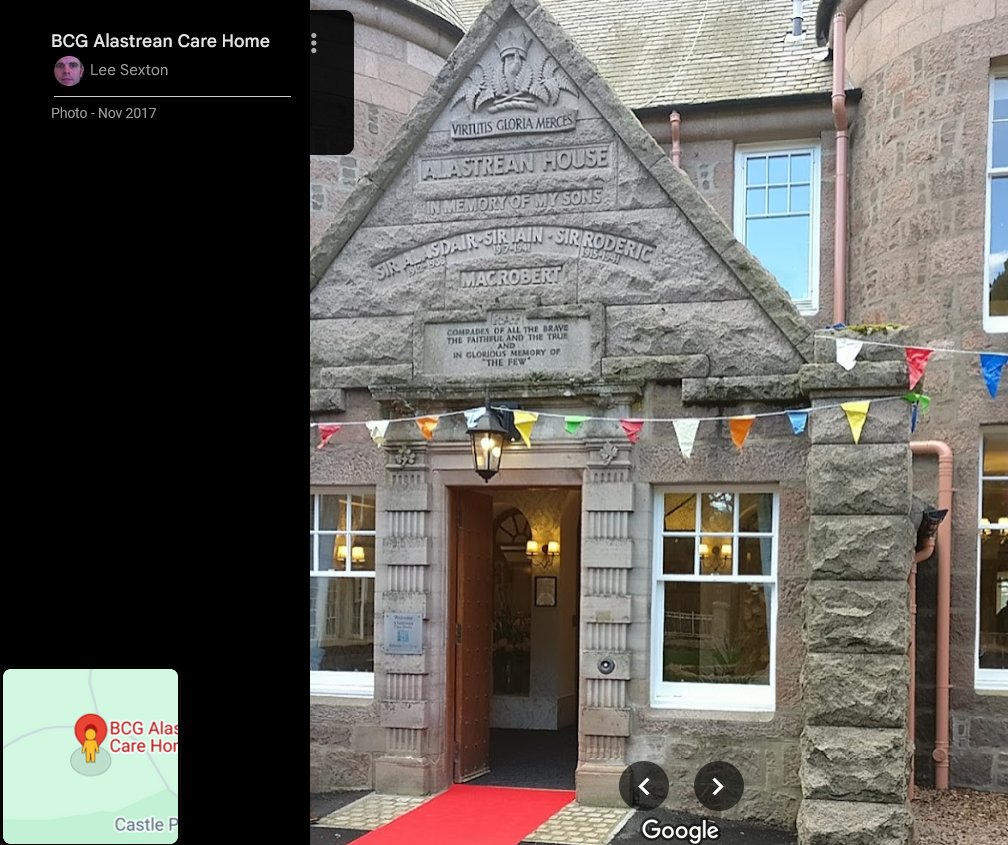
Alastrean House porch currently. Photo: Lee Sexton, Google Maps
But, as if enough tragedy had not already struck for Lady MacRobert, Alastrean House was then gutted by a terrible fire in 1952. One woman died after trying to leap from the window to escape the flames, whilst Lady MacRobert noted that many of the articles lost in the blaze were irreplaceable.[53] Only the granite memorial porch, carved with the family motto of ‘Glory is the Reward of Valour’, remained standing.[54] Lady MacRobert was said to have been ‘too upset to say what the future would hold in store for Alastrean’[55]; passing away just two years after the fire at the age of 70, it is possible that this was one heartbreak too many for her to take.
The MacRobert Trust
Yet, another legacy which she had created in 1943 could not be so easily destroyed: the MacRobert Trust.
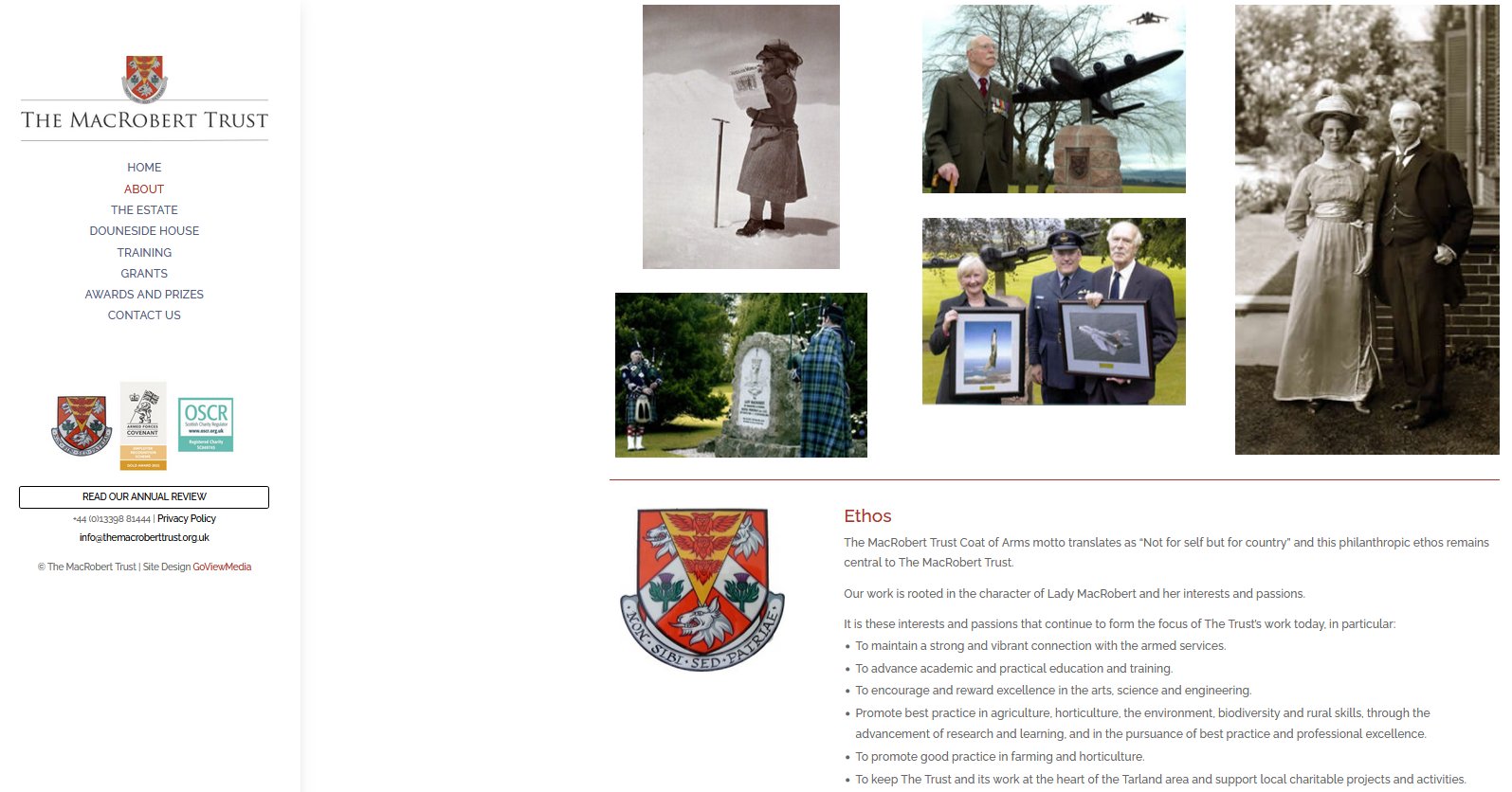
The MacRobert Trust website www.themacroberttrust.org.uk
Following her death in 1954, the Trust continued Lady MacRobert’s legacy through creating a number of charitable initiatives. Today, the charity funds grants, scholarships, and prizes to support young people across fields such as agriculture and farming, science, engineering, and aeronautics.[56] In addition, the MacRobert Trust provides awards to exceptional graduates of the Royal Air Force College Cranwell and the North East Scotland Air Training Corps, as well as offering flying scholarships with the Air League.[57] Eventually, Alastrean House was rebuilt and re-opened in April 1958, notably serving as a Royal Air Force Benevolent Fund retirement home for ex-RAF personnel from 1984 until 2005.[58] It is Lady MacRobert’s wartime donation of the four Hurricanes and one Stirling bomber to the RAF, however, that remains the most high-profile aspect of her legacy.
She once said of her contributions that they were ‘intended in the spirit of the MacRoberts – that where one falls, other MacRoberts shall take his place, threefold or fourfold, to carry on the fight. There are now no more male MacRoberts to carry on, but so long as these planes fly, there will be MacRoberts in the fight.’[59] Indeed, there are still MacRoberts in the fight: a Eurofighter Typhoon based with 6 Squadron at RAF Lossiemouth has borne the name ‘Sir Roderic’ since 2017.[60] As Lossiemouth is one of two Quick Reaction Alert (Interceptor) stations, this means that Britain is still protected today by a MacRobert Fighter.[61] Because of this homage, Sir Roderic remains the best-known Hurricane of the original four MacRobert Fighters.
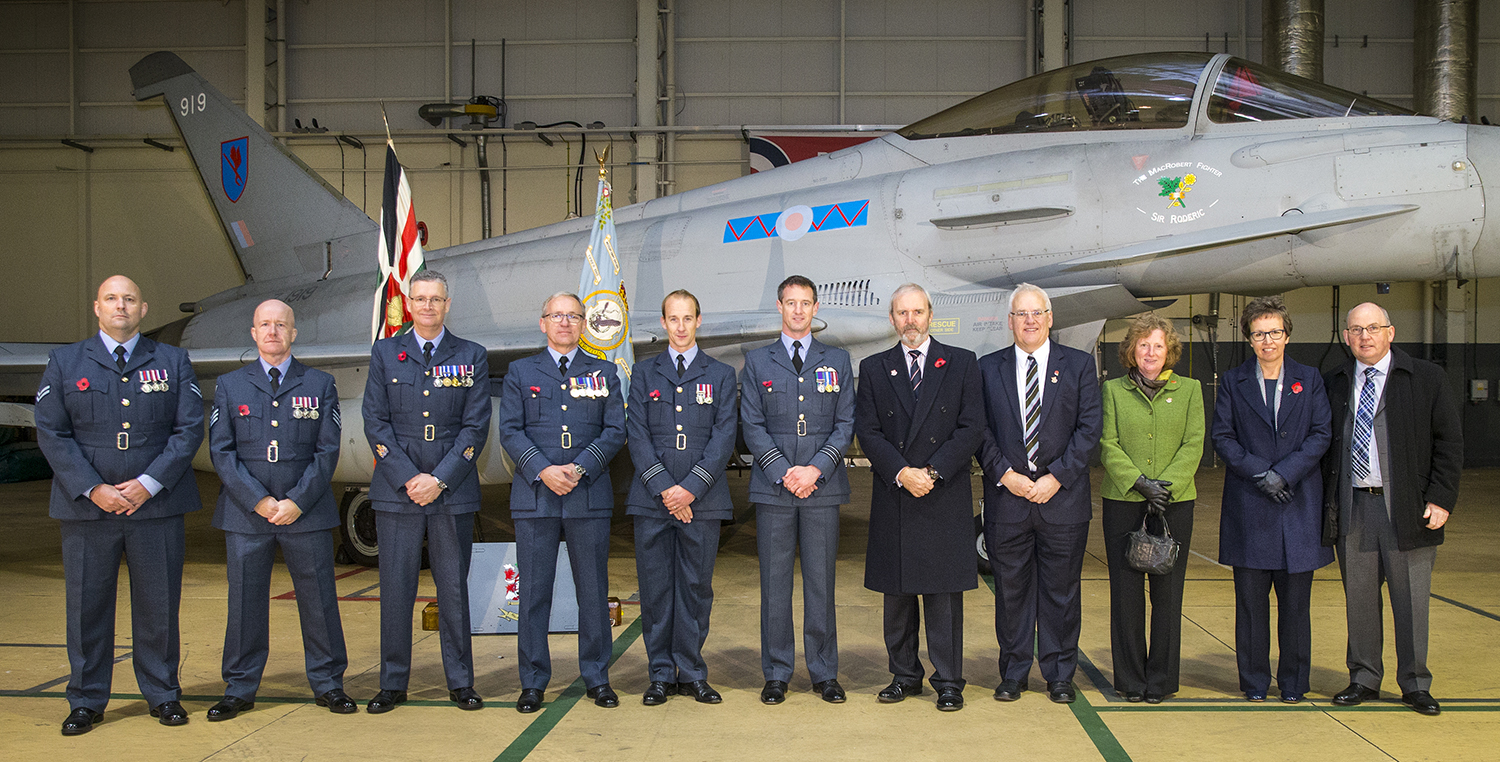 ‘The MacRobert Fighter – Sir Roderic’ – Eurofighter Typhoon II from No. 6 Squadron RAF. Photo: Royal Air Force
‘The MacRobert Fighter – Sir Roderic’ – Eurofighter Typhoon II from No. 6 Squadron RAF. Photo: Royal Air Force
In August 2024, the service medals, pilot’s logbook and uniform of Sir Roderic’s first pilot, ‘Blondie’ Walker, were proudly displayed in 6 Squadron’s Heritage Room.[62] During the RAF Centenary in 2018, donated items belonging to a 94 Sqn engineer who serviced the original Sir Roderic had also been held there.[63] Due to the various postwar incarnations of MacRobert’s Reply – from a Blackburn Buccaneer, to a Panavia Tornado – the original Stirling bomber is also generally well-remembered. Yet, through creating a dedicated model kit for one of the lesser-known MacRobert Fighters, Arma Hobby has ensured that the memory of Sir Iain and its namesake will also be preserved: a fundamental aspect of a remarkable story, in which every single aircraft – and individual – played their part to the fullest.
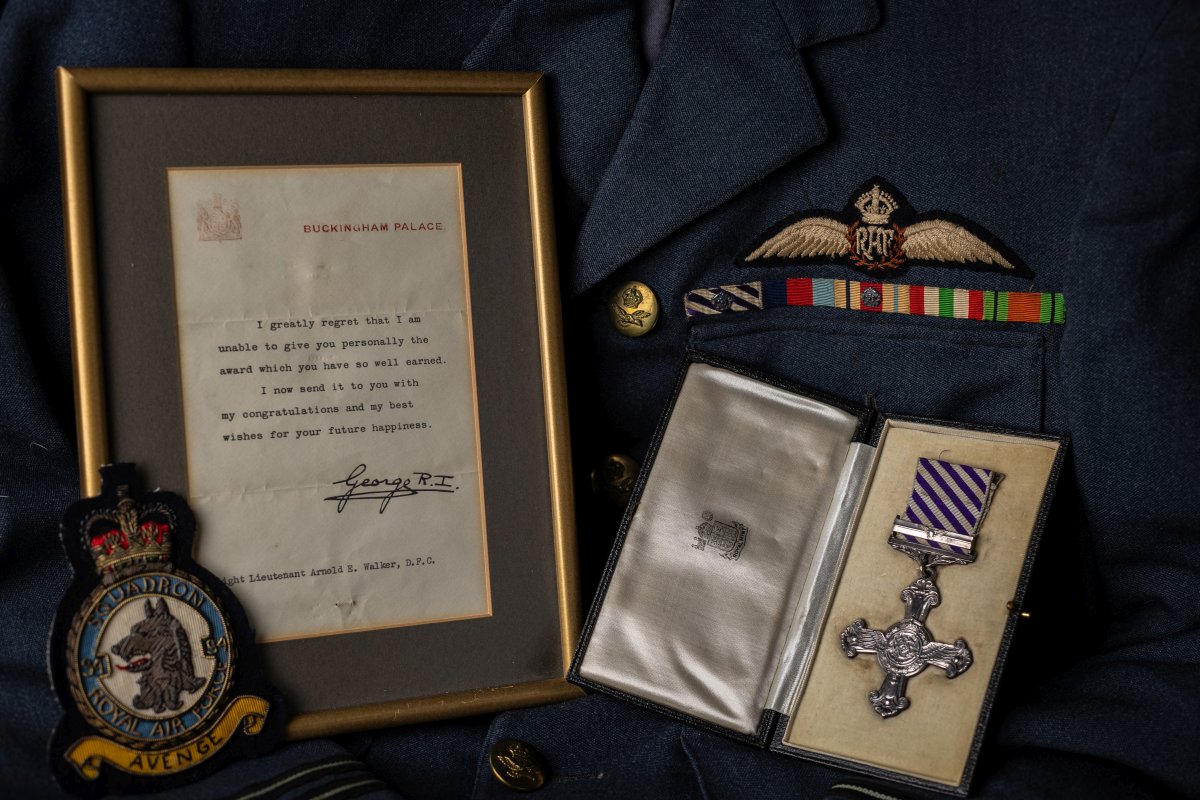
Service medals of ‘Sir Roderic’s’ first pilot, F/L Arnold ‘Blondie’ Walker and the No. 94 Squadron badge. Photo: Royal Air Force.
References – click to unroll
[1] ‘Lady MacRobert’s “Reply”’, Evening Express, Saturday 23 August 1941. The British Newspaper Archive (British Library).
[2] ‘Bereaved Mother’s £25,000 for a Bomber: Gift by Lady MacRobert on Receiving News About Her Sons in R.A.F.’, The Scotsman, Saturday 23 August 1941. The British Newspaper Archive (British Library).
[3] Ibid.
[4] W. E. J. Bullock, ‘Bits and Pieces from a Long Career’, International Bomber Command Centre Archive. Available online: https://ibccdigitalarchive.lincoln.ac.uk/omeka/collections/document/19134 [Accessed 08/11/2024]
[5] ‘Bereaved Mother’s £25,000 for a Bomber’, The Scotsman, Saturday 23 August 1941.
[6] ‘About’, The MacRobert Trust. Available online: https://www.themacroberttrust.org.uk/about/ [Accessed 02/11/2024]
[7] ‘Mother of R.A.F. Pilots Buys Bomber – One Son Killed: Other Is Missing, Reply “To The Mark”’.
Belfast News-Letter, Saturday 23 August 1941. The British Newspaper Archive (British Library).
[8] ‘Lady MacRobert, £20,000 Gift for Four R.A.F. Fighters, “Salute To Russia”’, The Scotsman, Wednesday 4 March 1942. The British Newspaper Archive (British Library).
[9] ‘Lady MacRobert’s “Reply”’, Evening Express, Saturday 23 August 1941.
[10] ‘Death of R.A.F.’s “Lady Bountiful”, Northern Daily Mail, Thursday 2 September 1954. The British Newspaper Archive (British Library).
[11] ‘Mother of R.A.F. Pilots Buys Bomber’, Belfast News-Letter, Saturday 23 August 1941.
[12] ‘Lady MacRobert’s “Reply”, Evening Express, Saturday, August 23, 1941
[13] ‘Lady MacRobert, £20,000 Gift for Four R.A.F. Fighters’, The Scotsman, Wednesday 4 March 1942.
[14] ‘Lady MacRobert’s “Reply”, Evening Express, Saturday 23 August 1941.
[15] ‘Mother of R.A.F. Pilots Buys Bomber’, Belfast News-Letter, Saturday 23 August 1941.
[16] ‘Salute to Russia: Four MacRobert Fighter Planes’, Press and Journal, Wednesday 4 March 1942. The British Newspaper Archive (British Library).
[17] ‘MacRobert’s Reply [Memorial] Dundee, Imperial War Museum, 16 May 2019. Available online: https://www.iwm.org.uk/memorials/item/memorial/58220 [Accessed 08/11/2024]
[18] Ibid.
[19] ‘Lady MacRobert’s Fighters in Action Soon: Sent to Son’s Squadron in Middle-East’, The Scotsman, Thursday 17 September 1942. The British Newspaper Archive (British Library).
[20] ‘Another MacRobert Gift: Four Hurricanes to Help Russians’, The Northern Whig and Belfast Post, Thursday 17 September 1942. The British Newspaper Archive (British Library).
[21] ‘Lady MacRobert’s Fighters in Action Soon: Sent to Son’s Squadron in Middle-East’, The Scotsman, Thursday 17 September 1942.
[22] Ibid.
[23] ‘MacRobert Aircraft – A Woman’s Courage and Sacrifice’, Supplement to The Argus, Saturday 16 January 1943, p.8. Available online: https://trove.nla.gov.au/newspaper/article/11347355 [Accessed 02/11/2024]. Trove Archive, National Library of Australia.
[24] Ibid.
[25] Ibid.
[26] Ibid.
[27] Film 1340.09, ‘The Name Of MacRobert Lives On’, British Pathé (1942). Available online: https://www.britishpathe.com/asset/82059/ [Accessed 29/10/2024]
[28] Ibid.
[29] ‘MacRoberts (sic) Fighters’, Associated Press/British Movietone (9 October 1942). Available online: https://newsroom.ap.org/editorial-photos-videos/detail?itemid=c6aa1ad0bb3345448ce61ecf90c538c0&mediatype=video&source=youtube [Accessed 29/10/2024]
[30] CM 3653. ‘Aircraft of the Royal Air Force 1939-1945: Hawker Hurricane. Five tropicalised Hurricane Mark IICs of No. 94 Squadron RAF based at El Gamil, Egypt, flying in loose starboard echelon formation.’ Available online: https://www.iwm.org.uk/collections/item/object/205126797 [Accessed 27/10/2024]. The Imperial War Museum, London. NB: Sir Iain is sometimes spelt as ‘Sir Iaian’, as in this IWM collection, but newspapers of the time and the MacRobert Trust spell it as ‘Iain’.
[31] MED0600. ‘Western Desert, Egypt. 20 September 1942. Air Vice Marshal W. A. McCloughry (sic) shakes hands with Flight Sergeant D. Wood, pilot of the aircraft named after Sir Iain MacRobert.’ Available online: https://www.awm.gov.au/collection/C353612 [Accessed 08/11/2024]. Australian War Memorial Photo Collection.
[32] The original article does not capitalise this as ‘The Few’, but it likely refers to the courage and bravery displayed by Hurricane and Spitfire fighter pilots during the Battle of Britain; ‘The Few’ became synonymous with them following Winston Churchill’s speech of the same name on 20 August 1940. See W. Churchill, ‘The Few’, House of Commons, 20 August 1940 [Speech] Available online: https://winstonchurchill.org/resources/speeches/1940-the-finest-hour/the-few/ [Accessed 07/11/2024]
[33] ‘The MacRoberts Fly Again’, The Sunday Post, Sunday 20 September 1942. The British Newspaper Archive (British Library).
[34] Ibid.
[45] CM 3653. ‘Aircraft of the Royal Air Force 1939-1945: Hawker Hurricane. Five tropicalised Hurricane Mark IICs of No. 94 Squadron RAF based at El Gamil, Egypt’, Imperial War Museum.
[36] C. Clifford, ‘Another 1/48 Hurricane from Arma Hobby’, Key Model World, 10 October 2023. Available online: https://www.keymodelworld.com/article/arma-hobby-148-hawker-hurricane-mkiic-trop [Accessed 08/10/2024]
[37] Ibid.
[38] Defence Update, Issues 85-92 (1988), 35.
[39] T. O’Toole et. al, Hawker Hurricane and Sea Hurricane (Barnsley: Pen & Sword, 2014), 21.
[40] P. E. Eden, The Official Illustrated History of RAF Search and Rescue (London: Bloomsbury, 2020), 20.
[41] O’Toole et. al, Hawker Hurricane and Sea Hurricane, 21.
[42] Eden, The Official Illustrated History of RAF Search and Rescue, 20.
[43] P. E. Eden & S. Moeng (eds.), Aircraft Anatomy of World War II: Technical Drawings of Key Aircraft 1939-1945. 2003. (New York: Chartwell Book, 2016), 131.
[44] D. Berliner, Surviving Fighter Aircraft of World War Two: A Global Guide to Location and Types (Barnsley: Pen & Sword, 2011), 67.
[45] O’Toole et. al, Hawker Hurricane and Sea Hurricane, 21.
[46] See F. R. van der Linden, The Nation’s Hangar: Aircraft Treasures of the Smithsonian (Washington, D.C.: Smithsonian Books, 2011), 101; ‘Hawker Hurricane Mark IIc’, RAF Museum Cosford. Available online: https://collections.rafmuseum.org.uk/collection/object/object-18950/ [Accessed 08/10/2024]
[47] A total of 14, 233 Hurricanes were produced during the Second World War; 4,711 of these were Mk IIc. The latter figure is sometimes given for all Hurricane Mk IIs produced – but, according to the British Air League, 2,948 of the Mk II Hurricanes produced during the war were Mk IIb and 4,711 were designated as Mk IIc. See Air Pictorial, Volume 57, 1958 (Air League of the British Empire: 1995), 321; also Linden, The Nation’s Hangar,101.
[48] ‘Death of R.A.F.’s “Lady Bountiful”, Northern Daily Mail, Thursday 2 September 1954.
[49] ‘Obituaries: Arnold Edgar Walker’, Heath Old Boys Association, 27 August 2020. Available online: https://heatholdboys.org.uk/obits/Walker_A.html [ Accessed 01/11/2024]
[50] LB49157. ‘Alastrean House’, Historic Environment Scotland. Available online: https://portal.historicenvironment.scot/apex/f?p=1505:300:::::VIEWTYPE,VIEWREF:designation,LB49157 [Accessed 09/11/2024]
[51] ‘Alastrean House’, The MacRobert Trust. Available online: https://www.themacroberttrust.org.uk/alastrean-house/ [Accessed 02/11/2024]
[52] ‘Death of R.A.F.’s “Lady Bountiful”, Northern Daily Mail, Thursday 2 September 1954.
[53] ‘Fire Guts Gift-Mansion of Lady MacRobert; Woman leaps to death from top floor; seven of staff escape in Night Clothes’, The Courier and Advertiser, Monday 1 December 1952. The British Newspaper Archive (British Library).
[54] Ibid.
[55] Ibid.
[56] ‘About‘, The MacRobert Trust. [website]
[57] Ibid.
[58] Ibid.
[59] ‘So Long as Planes Fly, They’ll Be MacRoberts In The Fight’, Aberdeen Weekly Journal, 24 September 1942.
[60] Ministry of Defence, Cabinet Office, Office of the Secretary of State for Scotland & The Rt Hon Damian Green, ‘First Secretary salutes RAF Lossiemouth contribution to UK Defence’, GOV.UK, 8 November 2017. Available online: https://www.gov.uk/government/news/first-secretary-salutes-raf-lossiemouth-contribution-to-uk-defence [Accessed 08/11/2024]
[61] Ibid.
[62] ‘Belongings of original ‘Sir Roderic’ ship-busting pilot returned to 6 Squadron’, RAF Lossiemouth News, 7 August 2024. Available online: https://raf.mod.uk/our-organisation/stations/raf-lossiemouth/news/belongings-of-original-sir-roderic-ship-busting-pilot-returned-to-6-squadron/ [Accessed 09/11/2024]
[63] ‘WWII Donation To RAF Lossiemouth Remembers Sir Roderic’, RAF Lossiemouth News, 27 September 2018. Available online: WWII Donation To RAF Lossiemouth Remembers Sir Roderic | Royal Air Force [Accessed 08/11/2024]
See also:
Dr Victoria Taylor is an award-winning aviation historian. She has published in various mainstream publications including BBC History Extra, Britain at War, and History of War magazines. Victoria has also served as both an on-screen expert and off-screen consultant for a number of historical documentaries for television and radio, including the BBC, Channel 5, History Hit, Sky History, National Geographic, the Smithsonian Channel, British Forces Broadcasting Service, and the RAF Benevolent Fund.
This post is also available in:
 polski
polski


